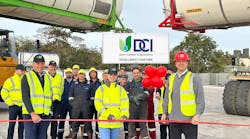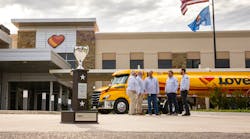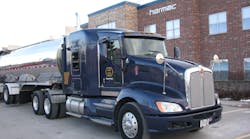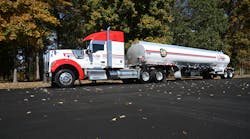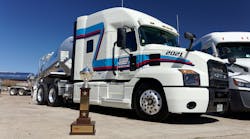FROM Rick Ochsendorf’s vantage point, safety was nothing more than a sidebar as little as five years ago. Companies felt they needed to comply and needed to have electronic logs only because the customer wanted them.
It’s a different scenario now. Executives have gotten onboard and are pushing the initiatives.
“That is so critical to the success of an organization,” said Ochsendorf, senior vice-president of operations and product management for PeopleNet. “There are a lot of dollars that are laying out there.”
In his presentation, “Electronic & Integrated: The New eDVIR and Beyond,” Ochsendorf said drivers’ actions have sobering consequences. He spoke during the National Tank Truck Carriers’ Tank Truck Safety & Security Council annual meeting June 3-5 in San Antonio, Texas.
He said that in 2011, 3,757 people were killed and 88,000 injured in large-truck crashes, and the estimated costs of commercial motor vehicle crashes were $39 billion for fatalities, $32 billion for injuries and $16 billion for property damage, for a total of $87 billion.
He added that when a driver/truck is responsible for an accident, there are six main reasons: driver decision (driving too fast for conditions, following too closely), 38%; driver recognition (inattentive/distracted driving), 28%; non-performance (driver fell asleep or was physically impaired), 12%; performance (driver panicked, overcompensated, or exercised poor control), 9%; vehicle failure, 10%; and environment, 3%.
He said $8.7 billion could be saved in lives, injuries, and property damage with a sound inspection/preventive maintenance program, including proactive monitoring.
“To go beyond that number, I had a personal experience years ago where one of my best drivers was down in Alabama, driving at night,” he said. “Four high school kids were drunk and pulled out in front of him. He ran into them and killed them all. They were drunk and in the wrong, but his brakes were out of adjustment. Guess what happened to us? We almost went out of business. I look at that not only from the cost-of-going-out-of-business perspective, but that teens make bad decisions, and anything we can do to avoid those kinds of things and put drivers into positions to be safer and deal with the idiots out there is really important—even beyond the numbers.”
Ochsendorf said that with electronic DVIR driver input, the idea is to make sure the driver has everything so that he’s able to choose.
“And give him a quick out,” he said. “We don’t want to waste their time. Don’t make drivers go through a list of 50 items and make them check every one: ‘Clear … clear … clear.’
“We have all this data available to us coming from the onboard system, and it’s running through the network center and it’s sent out through the interface to our partners. Whether that’s your own system or TMT or some other provider that’s consuming data, it’s critical that we build it integrated into this format. We want it automated so it’s easy to work with.”
He said third-party devices, electronic logs, engine data, OBC messaging, driver messaging, and GPS location go to the data center, which goes to the PeopleNet Fleet Manager or open interface APIs (messaging and forms, edriver logs, vehicle management, decision tree forms, automated workflow, location, and g3 services.)
He said fault-code notifications are visible to the driver and office staff, and a proactive evaluation of meaningful codes and corrective action is the key to success.
Remote diagnostic link and Navistar OnCommand alarms focus on proactive actions to prevent greater issues: low battery, sudden start and stop, speed alarm, hours of service warning, movement without logging, roll stability events, diesel exhaust fluid tank alarm, diesel particulate filter alarm, tire pressure monitoring, and forward collision warning.
“There’s so much activity that happens with fault codes and there is so much confusion around fault codes,” he said. “It’s important that you have a process to understand all of this. Some companies are very sophisticated where they’re putting these codes into the backup system and analyzing them for their particular relevance and importance.”
The Drivewyze PreClear solution is focused on mobile-based weigh station bypass service. No hardware is required, and they are integrated with a PeopleNet TABLET, BLU2, and PD4. It covers fixed weigh stations and mobile inspection sites, and saves fuel, driver time, and other costs.
The first notification comes two miles out. Pre-clearance is requested one mile out and there is an in-cab notification. The vehicle passes by the weigh station, and an in-cab device resets after the vehicle exits the site.
“There is a large movement to collision-avoidance solutions,” he said. “We focus on integrated solutions so the back office can be notified about what’s happening in the cab. These are fantastic tools when it comes to avoiding accidents.”
He said lane-departure warnings save lives and improve safety by monitoring lane departures and following distances. It creates an historical record including the driver, date and time, vehicle, and location for the lane departure and headway warning events.
“The big thing with lane-departure systems is looking at megatrends,” Ochsendorf said. “The problem I’ve witnessed is that when companies get ahold of this information, they don’t have a process. If you don’t, you’ll get in trouble. You get the data and set up a process to deal with those solutions, because if you turn this on and get gobs of data and you come into a crash situation, the attorneys will come in and look at all this information and say, ‘You had this, this, and this, what did you do about it?’ If you don’t have any practices or procedures written up and documented, you need to do that because the attorneys will eat your lunch.”
Ochsendorf said tire management avoids accidents and downtime by monitoring tractor and trailer tire pressure and temperature. It alerts drivers and back- office personnel of issues in real time (tire pressure and temperature), reduces maintenance costs associated with tire management, increases miles per gallon through properly inflated tires, and does it for standard and non-standard vehicles.
Driver performance is monitored remotely via the EventAlerter application: sudden acceleration, sudden deceleration; stability events, headway/following, vehicle location, and messaging.
What’s in the future?
• Google’s self-driving vehicles. “There’s a lot of technology that needs to happen to get to that point. Some day maybe.”
• Sensors. “We’re going to start adding more sensors. Think about inspection of brakes and tire pressure. Why do you need to check tire pressure if you have a sensor? You look at no-zone areas that are such a challenge when it comes to vehicle accidents. Put a sensor on each one of them.” ♦

